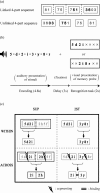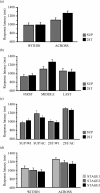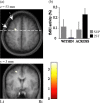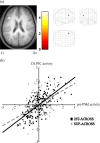Functional coupling of human prefrontal and premotor areas during cognitive manipulation
- PMID: 17392459
- PMCID: PMC6672123
- DOI: 10.1523/JNEUROSCI.4273-06.2007
Functional coupling of human prefrontal and premotor areas during cognitive manipulation
Abstract
Evidence indicates the involvement of the rostral part of the dorsal premotor cortex (pre-PMd) in executive processes during working memory tasks. However, it remains unclear what the executive function of pre-PMd is in relation to that of the dorsolateral prefrontal cortex (DLPFC) and how these two areas interact. Using functional magnetic resonance imaging (fMRI), brain activity was examined during a delayed-encoding recognition task. Fifteen subjects had prelearned several four-code standard sequences and super sequences (SUPs) consisting of a train of two standard sequences to form "chunks" in long-term memory. During fMRI, subjects remembered eight-code encoding stimuli presented as an SUP or two unlinked standard sequences (2STs). A memory probe prompted the subjects to recognize codes across two chunks (ACROSS) or within a single chunk. A 2 x 2 factorial design was used to test two types of working memory manipulation: (1) a reductive operation selecting codes from chunks ("segmenting") and (2) a synthetic operation converting unlinked codes into a sequence ("binding"). Response time data supported the behavioral effects of each operation. Event-related fMRI showed that the "segmenting operation" activated the DLPFC bilaterally, whereas the "binding operation" enhanced the left pre-PMd activity. Activity in the ventrolateral prefrontal cortex suggested its involvement in the retrieval of task-relevant information from long-term memory. Furthermore, effective connectivity analysis indicated that the left pre-PMd and ipsilateral DLPFC interacted specifically during the ACROSS recognition of 2STs, the condition that involved both operations. We propose specific neural substrates for working memory manipulation: the DLPFC for segmenting/attentional selection and the pre-PMd for binding/sequencing. The functional coupling between the DLPFC and pre-PMd appears to play a role in combining these distinct operations.
Figures






References
-
- Baddeley A. The episodic buffer: a new component of working memory? Trends Cogn Sci. 2000;4:417–423. - PubMed
-
- Barbas H, Pandya DN. Architecture and frontal cortical connections of the premotor cortex (area 6) in the rhesus monkey. J Comp Neurol. 1987;256:211–228. - PubMed
-
- Bor D, Cumming N, Scott CE, Owen AM. Prefrontal cortical involvement in verbal encoding strategies. Eur J Neurosci. 2004;19:3365–3370. - PubMed
-
- Braver TS, Cohen JD, Nystrom LE, Jonides J, Smith EE, Noll DC. A parametric study of prefrontal cortex involvement in human working memory. NeuroImage. 1997;5:49–62. - PubMed
-
- Callicott JH, Mattay VS, Bertolino A, Finn K, Coppola R, Frank JA, Goldberg TE, Weinberger DR. Physiological characteristics of capacity constraints in working memory as revealed by functional MRI. Cereb Cortex. 1999;9:20–26. - PubMed
Publication types
MeSH terms
LinkOut - more resources
Full Text Sources
Medical
